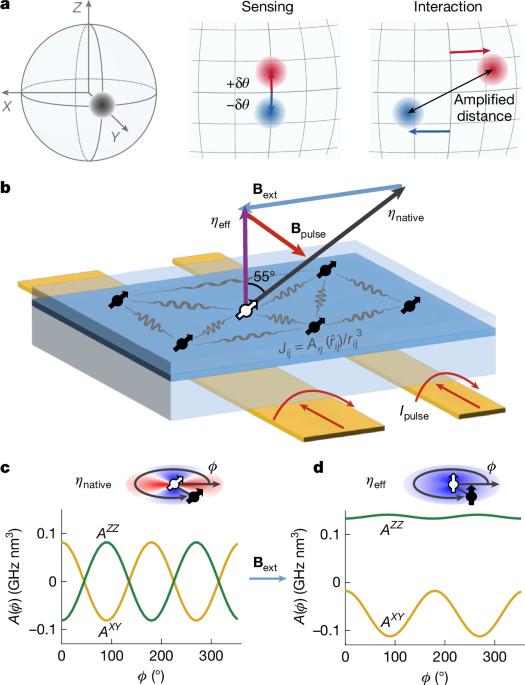Signal amplification in a solid-state sensor through asymmetric many-body echo
IF 48.5
1区 综合性期刊
Q1 MULTIDISCIPLINARY SCIENCES
引用次数: 0
Abstract
Electronic spins of nitrogen–vacancy centres in diamond constitute a promising system for micro- and nanoscale magnetic sensing1–4, because of their operation under ambient conditions5, ease of placement in close proximity to sensing targets6 and biological compatibility7. At high densities, the electronic spins interact through dipolar coupling, which typically limits8 but can also potentially enhance9 sensing performance. Here we report the experimental demonstration of many-body signal amplification in a solid-state, room-temperature quantum sensor. Our approach uses time-reversed two-axis-twisting interactions, engineered through dynamical control of the quantization axis and Floquet engineering10 in a two-dimensional ensemble of nitrogen–vacancy centres. We observe that optimal amplification occurs when the backward evolution time equals twice the forward evolution time, in sharp contrast to the conventional Loschmidt echo11,12. These observations can be understood as resulting from an underlying time-reversed mirror symmetry of the microscopic dynamics, providing key insights into signal amplification and opportunities for practical entanglement-enhanced quantum sensing. The experimental demonstration of many-body signal amplification in a solid-state, room-temperature quantum sensor is reported.

非对称多体回波在固态传感器中的信号放大
金刚石中氮空位中心的电子自旋构成了一个很有前途的微纳米级磁传感系统1 - 4,因为它们在环境条件下运行5,易于放置在传感目标附近6,并且具有生物相容性7。在高密度下,电子自旋通过偶极耦合相互作用,这通常会限制传感性能,但也有可能提高传感性能。在这里,我们报告了在固态室温量子传感器中多体信号放大的实验演示。我们的方法使用时间反转的两轴扭转相互作用,通过量化轴的动态控制和Floquet工程在二维氮空位中心系综中进行设计。我们观察到,当反向进化时间等于正向进化时间的两倍时,出现最佳放大,这与传统的Loschmidt回声形成鲜明对比。这些观察结果可以理解为微观动力学的潜在逆时镜像对称性,为信号放大和实际纠缠增强量子传感提供了关键见解。报道了多体信号放大在固态室温量子传感器中的实验演示。
本文章由计算机程序翻译,如有差异,请以英文原文为准。
求助全文
约1分钟内获得全文
求助全文
来源期刊

Nature
综合性期刊-综合性期刊
CiteScore
90.00
自引率
1.20%
发文量
3652
审稿时长
3 months
期刊介绍:
Nature is a prestigious international journal that publishes peer-reviewed research in various scientific and technological fields. The selection of articles is based on criteria such as originality, importance, interdisciplinary relevance, timeliness, accessibility, elegance, and surprising conclusions. In addition to showcasing significant scientific advances, Nature delivers rapid, authoritative, insightful news, and interpretation of current and upcoming trends impacting science, scientists, and the broader public. The journal serves a dual purpose: firstly, to promptly share noteworthy scientific advances and foster discussions among scientists, and secondly, to ensure the swift dissemination of scientific results globally, emphasizing their significance for knowledge, culture, and daily life.
 求助内容:
求助内容: 应助结果提醒方式:
应助结果提醒方式:


